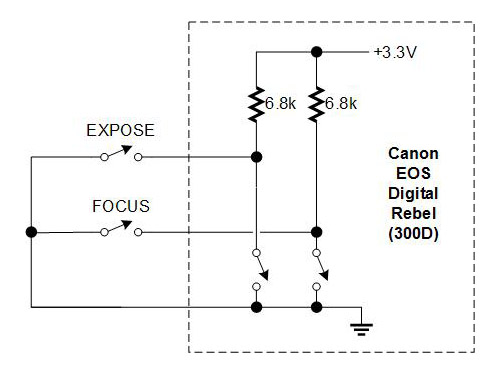I'm a total electronics n00b set out to create an intervalometer for my Canon EOS 350D camera which seemed super simple from the outset, but I got a bit blocked with creating a switch using a transistor.
I don't fully understand the inner workings of the transistor and got lost with things like having to saturate it, using a shorting resistor, calculating voltage / current / resistance, etc to get the whole thing to act as a binary switch.
The camera circuit I want to switch is super simple and low powered (each switch carries about 0.5 mA at 3.3 volts):

(Source: http://www.covingtoninnovations.com/dslr/CanonRelease.html )
For now I only want to get the expose bit working as it seems I'll only need to duplicate that for focus.
For the controlling circuit I want to use an IOIO board, which is very similar to an Arduino being a programmable controller with a variety of I/O pins to interface with whatever you throw at it.
I have a bunch of P2N2222A transistors which even with my limited knowledge seem to be usable for this purpose and a resistor kit with 20 values, but I'm not really sure how to combine them or if I need to get a diode too to get this working.
So far I tried connecting the Canon circuit to the Collector and Emitter legs of the transistor and then connecting to the Base the 5V pin from a battery through a 2.2K resistor (which the transistor came with) hoping that it will just work, but nothing happened :) At the moment I'm trying to get it working without the IOIO just to simplify things and to not fry it if I do something wrong :)
I got the idea from this diagram by the way:

( Source: http://www.mayothi.com/transistors.html )
It seems strange to me though that the controlling circuit is not really a circuit just a one way thing, and reading about shorting resistors on other pages I guess I'd need to connect the grounds together somehow and use a higher resistance resistor in it? Or maybe even a diode? Please help!

